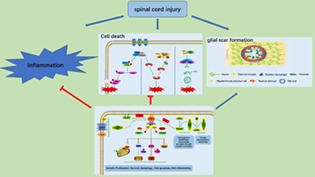- Record: found
- Abstract: found
- Article: found
The PI3K/AKT signalling pathway in inflammation, cell death and glial scar formation after traumatic spinal cord injury: Mechanisms and therapeutic opportunities

Read this article at
Abstract
Objects
Traumatic spinal cord injury (TSCI) causes neurological dysfunction below the injured segment of the spinal cord, which significantly impacts the quality of life in affected patients. The phosphoinositide 3kinase/serine‐threonine kinase (PI3K/AKT) signaling pathway offers a potential therapeutic target for the inhibition of secondary TSCI. This review summarizes updates concerning the role of the PI3K/AKT pathway in TSCI.
Materials and Methods
By searching articles related to the TSCI field and the PI3K/AKT signaling pathway, we summarized the mechanisms of secondary TSCI and the PI3K/AKT signaling pathway; we also discuss current and potential future treatment methods for TSCI based on the PI3K/AKT signaling pathway.
Results
Early apoptosis and autophagy after TSCI protect the body against injury; a prolonged inflammatory response leads to the accumulation of pro‐inflammatory factors and excessive apoptosis, as well as excessive autophagy in the surrounding normal nerve cells, thus aggravating TSCI in the subacute stage of secondary injury. Initial glial scar formation in the subacute phase is a protective mechanism for TSCI, which limits the spread of damage and inflammation. However, mature scar tissue in the chronic phase hinders axon regeneration and prevents the recovery of nerve function. Activation of PI3K/AKT signaling pathway can inhibit the inflammatory response and apoptosis in the subacute phase after secondary TSCI; inhibiting this pathway in the chronic phase can reduce the formation of glial scar.
Conclusion
The PI3K/AKT signaling pathway has an important role in the recovery of spinal cord function after secondary injury. Inducing the activation of PI3K/AKT signaling pathway in the subacute phase of secondary injury and inhibiting this pathway in the chronic phase may be one of the potential strategies for the treatment of TSCI.
Abstract
During secondary injury after spinal cord injury (SCI), recovery is impaired by inflammation, cell death and glial scar formation. Therefore, these pathological processes may be potential treatment targets for SCI. The phosphoinositide 3‐kinase/serine‐threonine kinase (PI3K/AKT) signalling pathway has a key role in the secondary injury after SCI. PI3K/AKT signalling pathway can inhibit the inflammation and cell death after SCI, and can also promote the formation of glial scar.
Related collections
Most cited references250
- Record: found
- Abstract: found
- Article: not found
Inflammation and cancer.
- Record: found
- Abstract: found
- Article: not found
Neutrophil recruitment and function in health and inflammation.
- Record: found
- Abstract: found
- Article: not found
